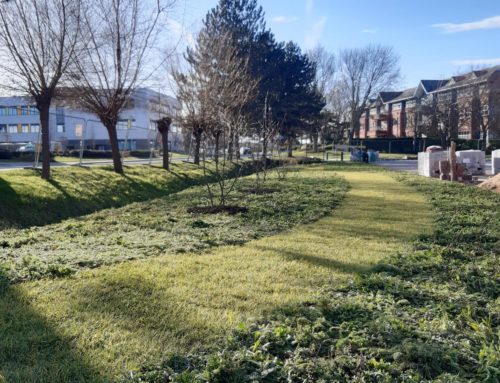Access to Green Space and Workplace Wellbeing
By Veronica Flemming, Senior Landscape Architect
Summer is coming to a close and Autumn has arrived. With it comes cooler temperatures, darker evenings and a natural tendency for us to want to hunker down and stay inside. At work, this translates into sitting at our desks for hours and staying in the office at lunchtimes, only venturing out when it’s time to go home.
However cold and gloomy it looks from the office window, staying inside all day is not good for our wellbeing.
In 2018 a research team from the University of East Anglia gathered evidence from over 140 studies, to see whether nature really does provide a tangible health benefit. They found that regular exposure to greenspace reduces the risk of serious long-term health problems.
‘Greenspace’ was defined as open, undeveloped land with natural vegetation as well as urban greenspaces, which included urban parks and street greenery.
The team analysed how the health of people with little access to greenspaces compared to that of people with the highest amounts of exposure.
We found that spending time in, or living close to, natural green spaces is associated with diverse and significant health benefits. It reduces the risk of type II diabetes, cardiovascular disease, premature death, and preterm birth, and increases sleep duration.
Lead Author Caoimhe Tohig-Bennett, from UEA’s Norwich Medical School.
Furthermore: “People living closer to nature also had reduced diastolic blood pressure, heart rate and stress. In fact, one of the really interesting things we found is that exposure to greenspace significantly reduces people’s levels of salivary cortisol — a physiological marker of stress. This is really important because in the UK, 11.7 million working days are lost annually due to stress, depression or anxiety.”
As we all return to a new pattern of work, whether it’s remaining at home, going back to the office or a balance of the two; it’s important for our ongoing mental and physical wellbeing that we integrate into our working week time spent outside in greenspaces.
A 2015 UK research paper found that length of time spent in workplace greenspace had more impact on employee wellbeing than frequency. A daily 5-minute break outside is great, but to experience a real benefit to our wellbeing, it’s about investing decent pockets of time outside throughout the working week.
Many employers and landlords are re-evaluating their landscapes to help facilitate the wellbeing benefits they can provide to their staff and occupiers. New running and cycling paths as well as outdoor gyms enable staff to exercise in the fresh air, whatever the season.
Enhanced planting schemes offer a visual boost year-round, whilst outdoor working and meeting spaces allow employees to work in the fresh-air and enjoy a decent chunk of time outside, rather than doing the same task sitting indoors.
Every inch of commercial landscape can play a role in positively contributing to the mental and physical health and wellbeing of occupiers and employees. This isn’t something which is exclusive to premises with lots of space. Built up areas can benefit from green walls and green roofs and the subsequent creation of a green view shouldn’t be underestimated in its benefit to employee wellbeing. Studies attribute the effects of green window views to ‘micro restorative’ experiences. Although a glimpse of nature through a workplace window is brief, it is enough to provide employees with the micro restorative benefits which have a significant cumulative impact on wellbeing.
As landscape architects and experts in business park design and management, we are passionate about designing environments that improve employee wellbeing. We can integrate features such as outdoor gyms, green walls and breakout spaces providing the welcome boost that bricks and mortar just can’t compete with.














